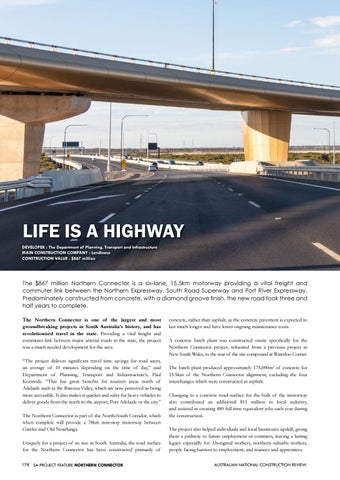LIFE IS A HIGHWAY DEVELOPER : The Department of Planning, Transport and Infrastructure MAIN CONSTRUCTION COMPANY : Lendlease CONSTRUCTION VALUE : $867 million
The $867 million Northern Connector is a six-lane, 15.5km motorway providing a vital freight and commuter link between the Northern Expressway, South Road Superway and Port River Expressway. Predominately constructed from concrete, with a diamond groove finish, the new road took three and half years to complete. The Northern Connector is one of the largest and most groundbreaking projects in South Australia’s history, and has revolutionised travel in the state. Providing a vital freight and commuter link between major arterial roads in the state, the project was a much needed development for the area. “The project delivers significant travel time savings for road users, an average of 10 minutes depending on the time of day,” said Department of Planning, Transport and Infrastructure’s, Paul Kermode. “This has great benefits for tourism areas north of Adelaide such as the Barossa Valley, which are now perceived as being more accessible. It also makes it quicker and safer for heavy vehicles to deliver goods from the north to the airport, Port Adelaide or the city.” The Northern Connector is part of the North-South Corridor, which when complete will provide a 78km non-stop motorway between Gawler and Old Noarlunga. Uniquely for a project of its size in South Australia, the road surface for the Northern Connector has been constructed primarily of 178 SA PROJECT FEATURE NORTHERN CONNECTOR
concrete, rather than asphalt, as the concrete pavement is expected to last much longer and have lower ongoing maintenance costs. A concrete batch plant was constructed onsite specifically for the Northern Connector project, relocated from a previous project in New South Wales, to the rear of the site compound at Waterloo Corner. The batch plant produced approximately 175,000m3 of concrete for 15.5km of the Northern Connector alignment, excluding the four interchanges which were constructed in asphalt. Changing to a concrete road surface for the bulk of the motorway also contributed an additional $11 million to local industry, and assisted in creating 480 full time equivalent jobs each year during the construction. The project also helped individuals and local businesses upskill, giving them a pathway to future employment or contracts, leaving a lasting legacy especially for Aboriginal workers, northern suburbs workers, people facing barriers to employment, and trainees and apprentices. AUSTRALIAN NATIONAL CONSTRUCTION REVIEW




















